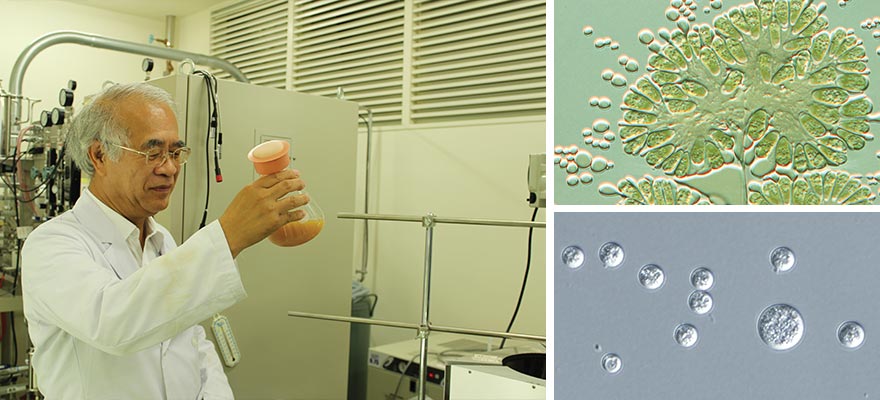Home > Highlighting JAPAN >Highlighting Japan June 2014>Science & Technology
Highlighting JAPAN
Science & Technology
Algae Power
Developing algal biomass as a practical energy source

Amid claims that fossil fuels like petroleum will run out in the next few decades, biomass resources are drawing attention as a form of renewable energy. Scientists led by Professor Makoto Watanabe of the University of Tsukuba Faculty of Life and Environmental Sciences are researching the practical development of algal biomass as a solution to the energy problem.
The term “renewable energy” tends to make us think of electric power usage, but that represents no more than 20 percent of the forms of energy used in Japan. More than 50 percent consists of fuels like gasoline for transport and raw materials for petroleum products like plastic. In other words, we need alternatives to petroleum that do more than generate electricity.
In that regard, algae are capable of producing oil as one of the metabolites of photosynthesis. Using oil crops such as various grains as biofuel creates the risk of steep price rises for food and animal feed. Algae have no such issues.
Some species of algae contain large amounts of lipids within their cells. There are around forty thousand identified species of algae, and it is estimated that there are from three hundred thousand to over ten million species including unidentified ones. The selection of algae for stable fuel production with high efficiency and low cost is of critical significance. Professor Watanabe thus focused his attention on two types of algae, Botryococcus and Aurantiochytrium, as biomass resources.
Botryococcus uses photosynthesis to produce a hydrocarbon close to petroleum that can be used to produce transportation fuels. However, climate conditions in Japan—which include a long period of low temperatures as well as relatively short annual sun exposure — are an impediment to the mass cultivation of Botryococcus.
Aurantiochytrium, discovered by Professor Watanabe’s team, grows not through photosynthesis but by feeding on organic matter. Although its hydrocarbon content is a little lower than that of Botryococcus, it greatly exceeds Botryococcus in hydrocarbon productivity and has a much higher growth rate. Since it does not need light, Aurantiochytrium can be cultivated in deep tanks, making it well suited to the limited space of Japan. Using organic wastewater and excess activated sludge from sewage treatment as the food for Aurantiochytrium makes it possible to produce energy efficiently at the lowest possible cost.
Professor Watanabe’s concept is a hybrid system in which characteristics of the two algae species complement each other in a positive way. The organic wastewater can be used for Aurantiochytrium culture, and the wastewater from Aurantiochytrium culture still containing an amount of nitrogen and phosphorus sources can be utilized as inorganic nutrients for Botryococcus culture. He also says it is important to make the entire process into a recycling system by, for example, utilizing the residues after extracting oil from Aurantiochytrium and Botryococcus as livestock feed.
The researchers are developing technologies including genetic improvement of algae to further enhance productivity, but beyond the technical issues, it is becoming necessary to systematize cooperation on a large scale with sewage treatment systems, farmers and other key elements. “Establishing a nationwide system of cooperation in Japan is essential,” says Professor Watanabe. We are slowly but steadily approaching the day when algae will make Japan an oil-producing nation.
© 2009 Cabinet Office, Government of Japan






